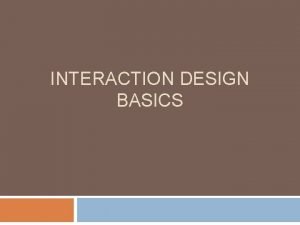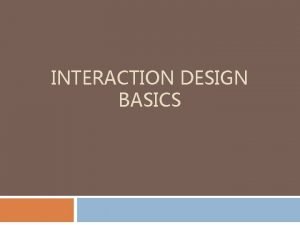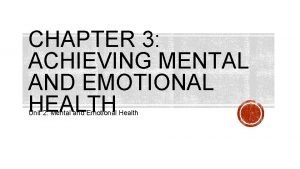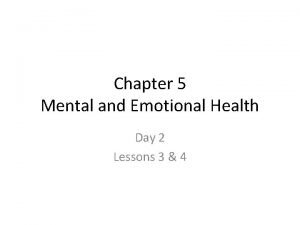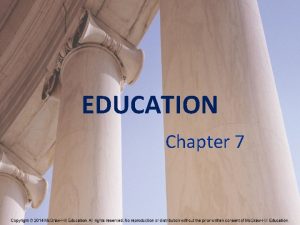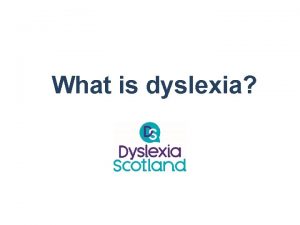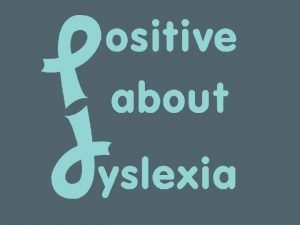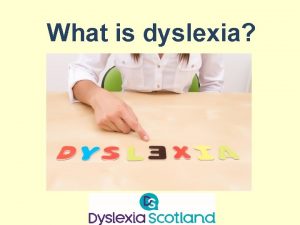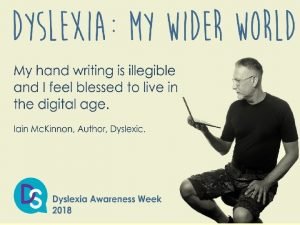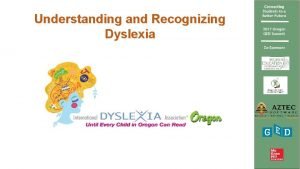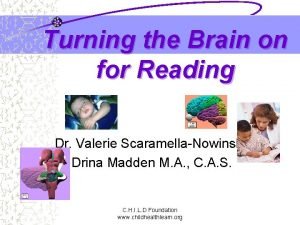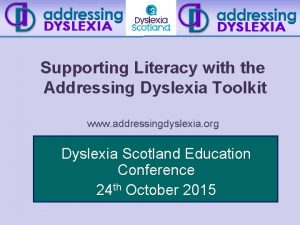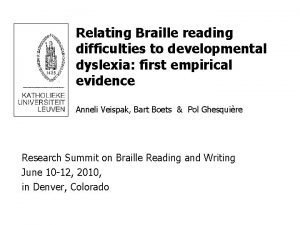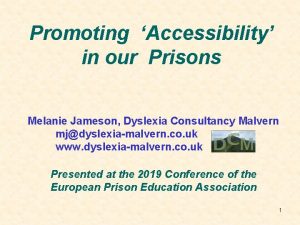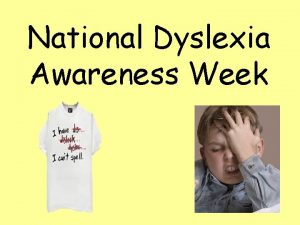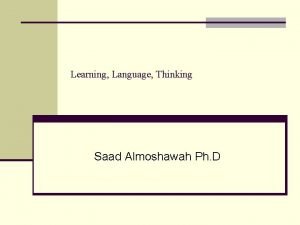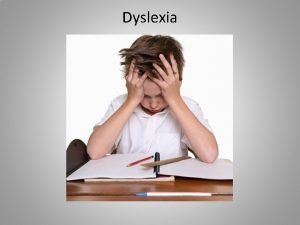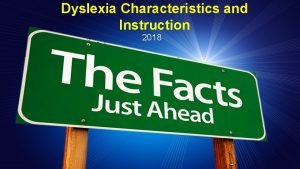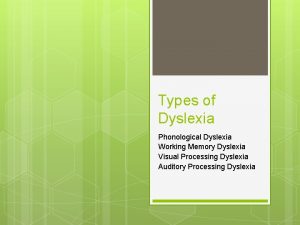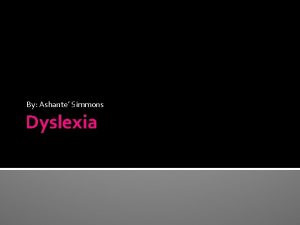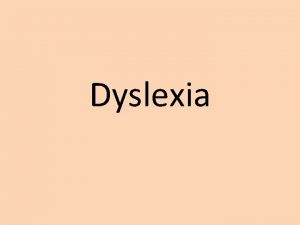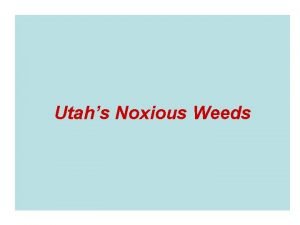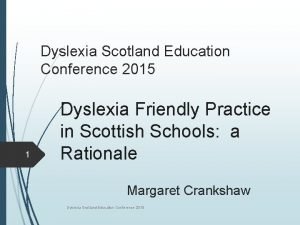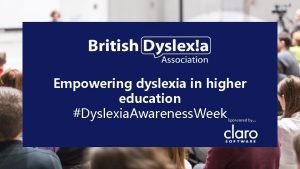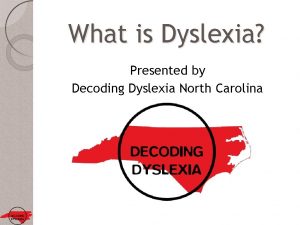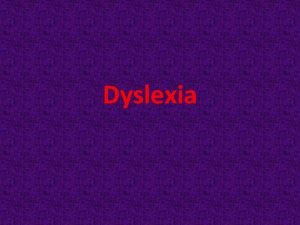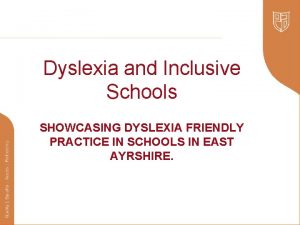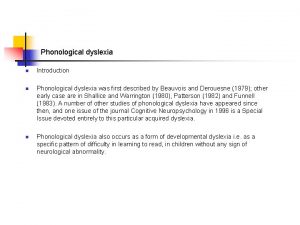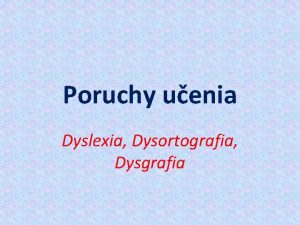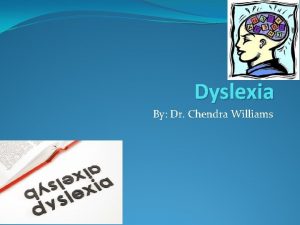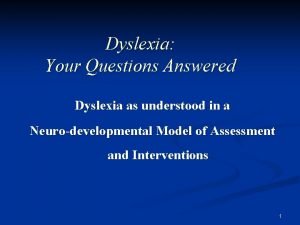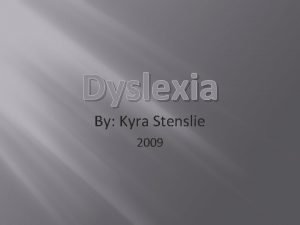Dyslexia Intervention Key to Achieving Utahs Education Goals


![Greek roots: dys·lex·i·a [dis-lek-see-uh] DYS= difficulty with LEXIA= language Greek roots: dys·lex·i·a [dis-lek-see-uh] DYS= difficulty with LEXIA= language](https://slidetodoc.com/presentation_image/6676971504abf703e25f1a0961bd45c7/image-3.jpg)
























- Slides: 27

Dyslexia Intervention: Key to Achieving Utah’s Education Goals Prepared by Decoding Dyslexia Utah Sept. 2018

Objectives for Today’s Meeting ○ Dyslexia 101: ○ ○ ○ Evidence-Based Interventions ○ ○ ○ Who, What, Where, and Why: DTI Simulation The power of an appropriate label-#saydyslexia Evidence-based reading instruction benefits all students, including those with dyslexia Early identification for dyslexia and other struggling readers Dyslexia in the Gen Ed. Classroom ○ ○ ○ What dyslexia looks like- warning signs Solutions and accommodations Technology in the classroom, how to level the playing field
![Greek roots dyslexia dislekseeuh DYS difficulty with LEXIA language Greek roots: dys·lex·i·a [dis-lek-see-uh] DYS= difficulty with LEXIA= language](https://slidetodoc.com/presentation_image/6676971504abf703e25f1a0961bd45c7/image-3.jpg)
Greek roots: dys·lex·i·a [dis-lek-see-uh] DYS= difficulty with LEXIA= language

What is dyslexia? ○ Dyslexia is a specific learning disability that is neurological in origin. ○ It is characterized by difficulties with accurate and/or fluent word recognition and by poor spelling and decoding abilities. ○ These difficulties typically result from a deficit in the phonological component of language that is often unexpected in relation to other cognitive abilities and the provision of effective classroom instruction. (International Dyslexia Association, 2002)

Secondary consequences may include: ○ Problems in reading comprehension and reduced reading experience that can impede growth of vocabulary and background knowledge. ○ Dyslexia is referred to as a learning disability because dyslexia can make it very difficult for a student to succeed academically in the typical instructional environment. (International Dyslexia Association, 2002)

The Dyslexic Brain “Because of dyslexia, my brain works differently, and I can see these patterns. I do have a gift that other people don’t have, and I will always stay ahead of the crowd and see more in an image than other people. ” Dr. Beryl Benacerraf- World-Renowned Radiologist & Expert in Ultrasound of Pregnancy

Step into a dyslexic’s shoes Simulation Experience from Dyslexia Training Institute

Dyslexia 101 -Debunking the Myths Myth #1 - Dyslexia is rare. False. ○ 1 in 5 = 20% gen. population ○ Utah Numbers: 90, 000 and 120, 000 students with Dyslexia in public schools Myth #2 - They see letters or words backwards. False. ○ Dyslexia is NOT a vision problem ○ Information takes different neurological route to connect letters with their sounds Myth #3 - Reading more over the summer would help. ○ More of the same approach doesn’t work ○ Intense appropriate intervention is needed Myth #4 - The Wait and See Approach. Maybe they will grow out of it? ○ Dyslexia is neurological/genetically inherited. One does not outgrow dyslexia ○ Waiting doesn’t help- impacts student’s emotional health, wastes valuable time

Who: Faces of Dyslexia

Sea of Strengths Leadership Curiosity Engineering Science Math Artist Creative Life Skills Out of the box thinker Good with models/Good with “hands on” Great imagination large vocabulary Excellent Reasoning skills Strong Spatial Relations Sees Balance/3 D Visual Entrepreneur/ Risk Taker Conceptualization See’s the “Big Picture” Eager to embrace new ideas Empathetic Resilient

Where are kids with dyslexia? Using the NIH 15 -20% pop. estimates: -Approx. 598, 832 students in Utah public schools in 2013 -14. -In Utah Special Ed. Classes, 31, 190 students receive services under Specific Learning Disability. The vast majority of these students are dyslexic (approximately 80%). -Leaving 60, 000 -90, 000 students with dyslexia in Utah in general education classrooms.

Why focus on Dyslexia? Dyslexia is neurological but treatment is EDUCATIONAL. ○ ○ Interventions are CRITICAL- if 90% of students are to be reading on grade level by 3 rd grade. (USOE benchmark) ○ #saydyslexia

Is learning to read easy or hard? 12%-18% need intensive help from highly trained educators to learn how to read 60% find learning to read a challenge 20%-30% learn to read easily with any kind of formal reading instruction 5% of students learn to read effortlessly (Lyon, 1997)

Part 2: Research and Evidence-Based Interventions

Benefits of Early Identification/Intervention ○ “The best current approach to the problem of reading failure is to allocate resources for prevention and early identification [alleviating the burden of remediation]. “ (American Academy of Pediatrics, 2011) ○ Torgesen reviewed many studies on early intervention and found that when intervention began in the 1 st grade, the expected incidence of reading disability of 12% -18% was reduced substantially to 1. 6% -6%. ”

Benefits of Early intervention o Early intervention means catching up to grader level faster. o Impacts all subject areas and improves self- esteem of student. o Relieves caseload of Sp. Ed. Program o Improves workload of future teachers

Research Study: Early identification of students at risk for dyslexia and other reading failures Cut off score- bottom 10% received intervention 45% False Positives (ID) Result 22% False Negatives Cut off score- bottom 20% received intervention Result 8% False Negatives (Torgeson and Burgess, 1998)

Accessing Language

Societal risk of waiting to see… o Drop out Rates • gen pop. . . ……… 8% vs. • o LD drop out rate…. . 20% Prison Studies (2002, 2012) • • General Population 15 -20% dyslexic Prison Population 50% dyslexic Dyslexia behind Bars (2012) and The Dyslexia Study in Texas Prisons (2002)

National Reading Panel: 5 Core Components of Early Reading Success ○ Phonemic awareness ○ Phonics ○ Fluency ○ Vocabulary ○ Comprehension

Evidence-Based Instruction includes: ○ intensive instruction ○ small groups (1 -3 students per teacher) ○ multisensory, explicit and systematic (Gabrielli, 2009)

Evidence-Based, Systematic, Explicit, Reading Interventions ○ ○ ○ Classic Orton-Gillingham Project Read Language! Slingerland Writing Road to Reading (Spalding) ○ Wilson Reading System (also Fundations) ○ S. P. I. R. E ○ Sonday System ○ Take Flight ○ Lexia-Herman Method ○ Starting Over ○ Barton Reading and Spelling ○ Sounds In Syllables ○ Association Method ○ Neuhaus

WHAT SO DIFFERENT ABOUT THESE INTERVENTIONS? They use Structured Literacy based instruction. Structured Literacy instruction is marked by several elements: ○Phonology ○Sound-Symbol Association ○ Syllable Instruction ○ Morphology ○ Syntax ○ Semantics Structured Literacy is distinctive in the principles that guide how critical elements are taught: ○ Systematic and Cumulative ○ Explicit Instruction ○ Diagnostic Teaching

Part 3: Dyslexia in the Classroom

Classroom Accommodations Fair does not mean treating every student exactly the same. Fair means providing each student with what that student needs to have a chance to succeed.

Assistive Technology Spellers ○ ○ ○ Franklin Speller Ginger Software Pulse Smart Pen Text to Speech ○ ○ ○ Read & Write for Google Chrome Learning Ally Audio Library Bookshare LAZ Library Intel Reader Natural Reader by Naturesoft Reading Apps ○ ○ ○ Reading Monster by Blue. Pin Sight. Words Pro by 24 x 7 digital LLC NLC Speed. Read by Neurolinguistic Learning Center Flashcards Delux (not lite) by orange or apple Read Me Stories by 8 interactive limited Speech to Text/Writing/Typing ○ ○ ○ ○ ○ Voice Activated Software Dragon Dictation by Nuance Read, Write and Type by Talking Fingers Taptyping – by Flairify Typ-o by Secondguess Apps Typing Class by Permeative Technologies abcpocketphonics by Apps in my Pocket i. Diary for Kids by Tipitap inc. Pictello by Assistiveware Turbo Scan (note taking)

Decoding Dyslexia Utah • Educate • Legislate • Advocate Website: www. decodingdyslexiautah. org Email: decodingdyslexiaut@gmail. com Facebook: https: //www. facebook. com/Decoding. Dyslexia. UT Facebook “Teachers for the OG Classroom: ” https: //www. facebook. com/groups/1557786424453810/
 Strategic goals tactical goals operational goals
Strategic goals tactical goals operational goals Strategic goals tactical goals operational goals
Strategic goals tactical goals operational goals Utahs state animal
Utahs state animal What is the state animal of utah
What is the state animal of utah Design is achieving goals within constraints
Design is achieving goals within constraints Design is achieving goals within constraints
Design is achieving goals within constraints Chapter 3 lesson 3 expressing emotions in healthful ways
Chapter 3 lesson 3 expressing emotions in healthful ways Chapter 3 lesson 2 health
Chapter 3 lesson 2 health Chapter 3 achieving mental and emotional health answer key
Chapter 3 achieving mental and emotional health answer key Emotional health defintion
Emotional health defintion Chapter 15 achieving mental and emotional health answer key
Chapter 15 achieving mental and emotional health answer key General goals and specific goals
General goals and specific goals Motivation in consumer behaviour
Motivation in consumer behaviour Government intervention in education
Government intervention in education Cost structure example business model canvas
Cost structure example business model canvas Key partners
Key partners What is dyslexia
What is dyslexia How many people have dislexia
How many people have dislexia What colour overlay is best for dyslexia
What colour overlay is best for dyslexia Mild dyslexia
Mild dyslexia Dyslexic meaning
Dyslexic meaning Valerie nowinski
Valerie nowinski Addressing dyslexia toolkit
Addressing dyslexia toolkit Orthographic dyslexia
Orthographic dyslexia Dyslexia assessment malvern
Dyslexia assessment malvern Dyslexia causes
Dyslexia causes Language of maharashtra
Language of maharashtra Different types of dyslexia
Different types of dyslexia




